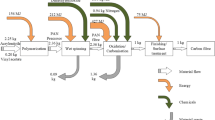Abstract
We consider a complex of problems of evaluating the residual lifetime of aircraft constructions after long-term operation. Some results of static and fatigue tests of a D16T-type aluminum alloy (in the as-delivered condition as well as after simulated and operating degradation) in air and a corrosive medium (3% NaCl solution) are presented. We have established characteristics that are the most sensitive to the degradation of constructional materials in the course of long-term operation. We also describe a new approach and correction factors for evaluating the fatigue durability of elements of aircraft constructions with regard for the degradation of materials.
Similar content being viewed by others
References
G. I. Nesterenko, “Fatigue and damage tolerance of ageing aircraft structures,” J. Soc. Nondestruct. Testing Monitor. Diagn., V.XXI, No. 3, 20–28 (2000).
O. P. Ostash, V. M. Uchanin, I. M. Andreiko, and I. R. Makoviichuk, “Engineering diagnostics and lifetime of constructions after long-term operation,” in: Physical Methods and Means of Control of Media, Materials, and Products [in Ukrainian], Kyiv (1999), pp. 3–8.
O. N. Romaniv, A. N. Tkach, I. R. Dzioba, et al., “Effect of long-term thermomechanical action on the crack resistance of 12Kh1MF steel,” Fiz.-Khim. Mekh. Mater., 25, No. 2, 87–92 (1989).
O. Z. Student, “Accelerated method of hydrogen degradation of structural steel,” Fiz.-Khim. Mekh. Mater., 34, No. 4, 45–52 (1998).
G. I. Nesterenko, “Calculation of the characteristics of operational survivability of aircraft constructions based on fracture mechanics,” Fiz.-Khim. Mekh. Mater., 19, No. 1, 12–20 (1983).
S. Ya. Yarema, O. P. Ostash, A. G. Vovnyanko, et al., “Effect of anisotropy, thickness, and operating time on crack growth in pressed and rolled semifinished items of D16chT and V95pchT1 alloys,” Fiz.-Khim. Mekh. Mater., 19, No. 1, 20–24 (1983).
K. Wakamatsu, M. Tsubota, Y. Kunii, and T. Iida, “Life prediction of aluminium-magnesium alloys for power transmission equipment,” in: Proc. Int. Sympos. Plant Aging Life Predict. Corrod. Struct. (Sapporo, Japan, May 15–18, 1995), Sapporo, Japan (1995), pp. 201–207.
O. D. Zinyuk, Determination of the Cyclic Crack Resistance of Constructional Magnesium and Aluminum Alloys and Their Welded Joints [in Russian], Author’s Abstract of Candidate-Degree Thesis (Eng.), Lvov (1987).
S. Ya. Yarema and I. B. Polutranko, “Cyclic crack resistance of pressed panels of D16chT and V95pchT1 alloys in liquid media,” Fiz.-Khim. Mekh. Mater., 19, No. 6, 56–59 (1983).
A. M. Dotsenko and G. B. Denisova, “Propagation of a fatigue crack in D16-T and V95-T1 aluminum alloys in tests in sprayed and unsprayed NaCl solutions,” Fiz.-Khim. Mekh. Mater., 18, No. 1, 51–53 (1982).
B. I. Ermolenko, “A study of the corrosive action of the environment on the growth rate of fatigue cracks,” Fiz.-Khim. Mekh. Mater., 15, No. 1, 12–15 (1979).
G. S. Neshpor, A. A. Armyagov, and D. A. Andreev, “Growth of fatigue cracks and fracture toughness of constructional aluminum alloys in air and 3.5% NaCl solution,” Fiz.-Khim. Mekh. Mater., 18, No. 4, 91–92 (1982).
A Study of the Cyclic Crack Resistance of High-Strength Aluminum Alloys [in Russian], Report on Contract No. 1135/081, Karpenko Physicomechanical Institute, Ukrainian Academy of Sciences, Lviv (1985).
Determination of the Resistance of High-Strength Aluminum Alloys to Fatigue Crack Initiation [in Russian], Report on Contract No. 1374/317, Karpenko Physicomechanical Institute, Ukrainian Academy of Sciences, Lviv (1987).
H. M. Nykyforchyn and O. Z. Student, “Effect of hydrogen on the formation of fatigue thresholds of constructional steels,” Fiz.-Khim. Mekh. Mater., 37, No. 2, 97–106 (2001).
O. P. Ostash, “New approaches in the mechanics of fatigue fracture,” Fiz.-Khim. Mekh. Mater., 42, No. 1, 13–25 (2006).
O. P. Ostash, “Application of the unified model of fatigue fracture of materials for the evaluation of their degradation in objects of long-term operation,” in: V. V. Panasyuk (editor), Fracture Mechanics of Materials and Strength of Structures [in Ukrainian], Karpenko Physicomechanical Institute, Ukrainian Academy of Sciences, Lviv (2004), pp. 457–464.
O. P. Ostash, V. M. Uchanin, I. M. Andreiko, and Yu. V. Holovatyuk, A Method for Determination of the Size of the Prefracture Zone [in Ukrainian], Patent of Ukraine, No. 64240A, Publ. 16.02.2004, Bull. No. 2 (2004).
O. P. Ostash, R. V. Chepil’, V. V. Vira, and V. T. Zhmur-Klymenko, “Prediction of the durability of cyclically loaded constructional elements,” Fiz.-Khim. Mekh. Mater., 41, No. 4, 39–44 (2005).
Author information
Authors and Affiliations
Additional information
__________
Translated from Fizyko-Khimichna Mekhanika Materialiv, Vol. 42, No. 4, pp. 5–16, July–August, 2006.
Rights and permissions
About this article
Cite this article
Ostash, O.P., Andreiko, I.M. & Holovatyuk, Y.V. Degradation of materials and fatigue durability of aircraft constructions after long-term operation. Mater Sci 42, 427–439 (2006). https://doi.org/10.1007/s11003-006-0098-1
Received:
Issue Date:
DOI: https://doi.org/10.1007/s11003-006-0098-1




